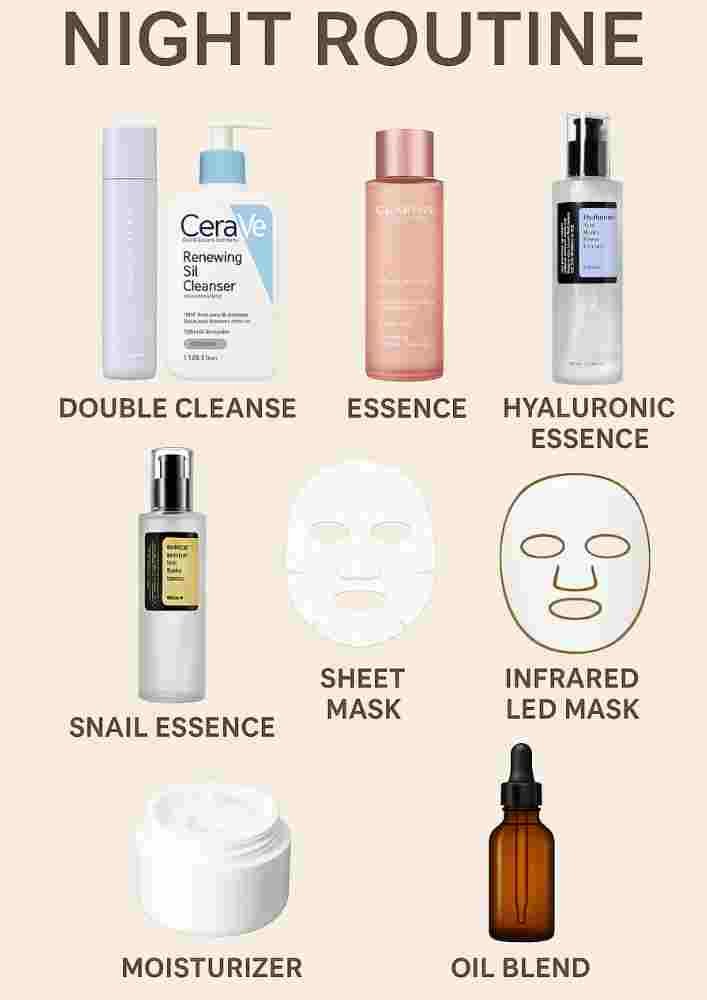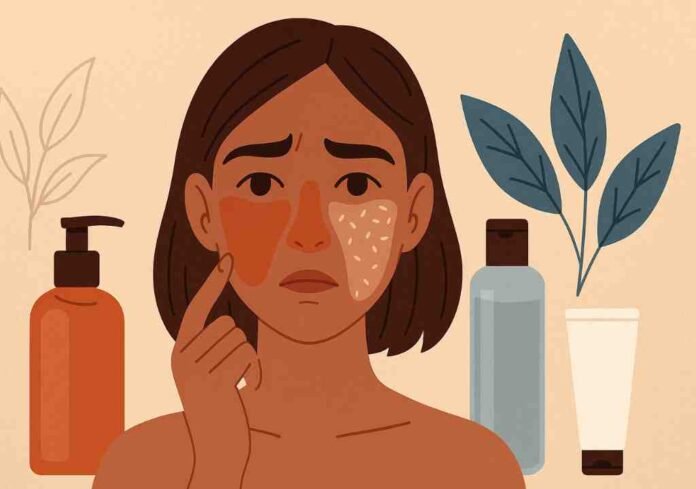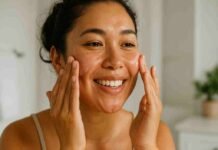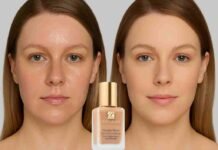Why Combination Skin Feels So Confusing
Table of Contents
Let’s be honest — learning how to build a skincare routine for combination skin can feel like trying to please two completely different faces. One part is slick with oil by noon, while the other is dry enough to feel tight or flaky. If that sounds familiar, you’re not alone. Combination skin is one of the most common (and confusing) skin types to manage.
Some days, you’re layering mattifying products to tame your T-zone, only to realize later that your cheeks are feeling parched. Other days, you try something nourishing, and boom — clogged pores or breakouts. That constant back-and-forth is what makes building the right routine such a challenge. But it’s not impossible — especially when you understand your skin’s needs and follow a smart plan.
Creating a balanced, effective routine isn’t about using trendy products or piling on ten different steps. It’s about choosing the right essentials, applying them in the correct order, and knowing when to switch things up. This layering products combo skin guide will show you how to hydrate without overloading, and how to control oil without drying you out.
The best part? You don’t need to spend a fortune. Even a budget combo skin skincare routine can deliver powerful results — if it’s done right. Whether you’re just starting out or tweaking what you already use, this step-by-step combo skin routine will walk you through everything you need to glow smarter, not harder.
Understanding Combination Skin
Before you reach for another product or try to fix what feels “off,” take a moment. Combination skin isn’t something you’re doing wrong — it’s just your skin asking to be understood. Some days it shines before lunch, other days it flakes before bedtime. It can feel unpredictable, like your face is trying to live in two climates at once. But the truth is, your skin isn’t confused — it’s just complex. It’s multitasking. And once you stop trying to fight that and start working with it, your routine becomes less of a struggle… and more of a partnership.

🔍 What Is Combination Skin?
Combination skin is like having two very different skin moods on one face — and neither is willing to compromise. Your T-zone (that’s your forehead, nose, and chin) is doing the most — shiny, oily, maybe throwing in a breakout or two — while your cheeks feel dry, tight, or quietly flaking in the background. You try to fix one thing, and suddenly the other goes off. Sound familiar? That’s the everyday dance of combo skin.
At its core, combination skin isn’t confused — it’s just multitasking. Some areas are working hard to protect you by producing oil, while others are simply asking for a little more moisture and care. Your skin isn’t being dramatic; it’s doing its best with what it’s given.
The tricky part? What calms one area can throw another into chaos. That toner that mattifies your nose might leave your cheeks stinging. That rich cream that soothes dryness? Your pores might not be so happy. It’s not about chasing perfect skin — it’s about finding a rhythm that works for your whole face, even if that means treating different parts a little differently.
Because in the end, your skin doesn’t need fixing — it just needs understanding. And once you stop fighting it and start listening, caring for it becomes a lot less stressful — and a lot more peaceful.
💡 Signs You Might Have Combination Skin
Still unsure whether you fall into the combo skin category? Here are some signs to look out for:
- Your T-zone gets shiny or greasy a few hours after washing your face
- Your cheeks feel tight, dry, or flaky, especially after cleansing
- You see blackheads or breakouts mainly on your forehead, nose, or chin
- Your skin reacts easily to new products — sometimes feeling irritated or patchy
- You notice your skin changes with the seasons or weather
If it feels like your skin has a split personality — oily and congested one day, dry and fussy the next — then you’re living the classic combination skin experience.
🔄 Why Combination Skin Is So Reactive
Here’s the tricky part: combination skin doesn’t stay the same year-round. It’s highly reactive to everything — the weather, your hormones, stress, diet, and especially the products you use.
In the summer, your T-zone might get oilier and more breakout-prone. Come winter, your cheeks suddenly feel parched and irritated. And while it’s tempting to treat one problem at a time, using the wrong products — like harsh exfoliants, drying toners, or too many actives — can throw everything out of balance.
This is why following a layering products combo skin guide can make such a difference. When you understand how to alternate between hydration, barrier care, and gentle treatments, your skin starts to feel more stable — and far less unpredictable.
🔎 Exploring the Types of Combination Skin

Combination skin isn’t just one experience — it’s a whole spectrum of shifting needs. Some days your forehead shines like a spotlight, other days your cheeks feel like sandpaper. And for many of us, it’s a little bit of both, all the time. That’s why no single routine works for everyone with combo skin — because your version of it is unique to you.
So instead of forcing your skin into someone else’s formula, let’s explore the most common types of combination skin — so you can finally understand what your skin has been trying to tell you all along.
5. Different Patterns of Combination Skin
Combination skin isn’t one-size-fits-all — it’s more like a spectrum. Some faces shine through the T-zone and flake around the edges. Others feel dry beneath the surface but still battle breakouts. And some change their mind entirely when the seasons shift.
That’s the thing — combo skin shows up in different ways for different people. So if you’ve ever copied someone’s “perfect” routine and ended up with clogged pores, irritated cheeks, or a face that just didn’t feel right… it’s not because you did something wrong. It’s because your skin needs its own unique rhythm — not someone else’s playlist.
The more you understand your skin’s specific pattern, the easier it becomes to care for. So let’s break down the most common types of combination skin — so you can stop guessing, start personalizing, and finally give your skin what it’s really asking for.
🔹 1. Classic T-Zone Combination Skin
If you’ve ever looked in the mirror and thought, “Why does my nose look like it’s been dipped in highlighter while my cheeks feel like parchment paper?” — you’re not alone. This is the most common and familiar form of combination skin, the kind we see referenced in product ads and skincare guides all the time. It’s that confusing mix where your T-zone — your forehead, nose, and chin — gets greasy halfway through the day, while the rest of your face just wants a drink of water.
🧴 What It Looks and Feels Like:
The center of your face tends to go into oil production overdrive, giving you that unwanted midday shine — maybe even the occasional breakout around your nose or chin. Meanwhile, your cheeks and jawline can feel tight, dry, or totally fine, depending on the day. It’s like your skin has two personalities that refuse to agree. One’s reaching for blotting papers, the other’s silently flaking under your makeup. And somehow, you’re supposed to care for both — at the same time.
🤹♀️ Why It’s Tricky to Manage:
Here’s where the real skincare tightrope begins. A creamy moisturizer feels like heaven on your cheeks… until your T-zone turns into a slip ‘n slide. A mattifying toner controls your shine… but suddenly your cheeks are begging for mercy. Every product feels like a risk — too heavy, too drying, or just too confusing. With classic T-zone combination skin, it’s not about doing more — it’s about learning to listen to what each part of your face is actually asking for. It’s personal. It’s delicate. And yes, it’s a little exhausting — but once you figure it out, it’s worth every bit of effort.
🔹 2. Dehydrated Combination Skin
This type of combination skin is the ultimate trickster. On the surface, it looks oily — maybe even shiny by noon. But underneath? Your skin is thirsty, not greasy. And unless you know what to look for, it’s easy to misread the signs.
🧴 What It Looks and Feels Like:
Your T-zone may still be oily, but there’s a tightness that lingers after you wash your face. Your makeup might melt off by lunchtime, yet somehow still looks cakey around the nose or cheeks. You might see flakiness under your foundation, even though you’re producing plenty of oil. That’s the thing — dehydrated skin lacks water, not oil. It’s trying to hydrate itself the only way it knows how: by pumping out more sebum.
💭 Why It Feels So Confusing:
You might find yourself in a loop — stripping away oil with cleansers or mattifying products, only to end up feeling tight, flaky, and uncomfortable. And so the skin produces even more oil to compensate. It becomes a cycle: oily but dull, shiny but tight. Your skin feels like it can’t win. And neither can you — unless you realize that what it really needs isn’t more drying, but deeper hydration.
Dehydrated combination skin is sneaky, because it mimics oily skin on the surface, while quietly screaming for moisture beneath. Once you start recognizing it for what it is, you’ll stop trying to “fix” the oil and start healing the thirst.
🔹 3. Acne-Prone Combination Skin
This version of combination skin doesn’t just ask for balance — it begs for relief. It’s oily in all the “wrong” places, dry where you need calm, and it often feels like your skin is picking a fight with you — even when you’re trying your best to take care of it.
🧴 What It Looks and Feels Like:
Your T-zone is constantly active, producing oil like it’s on a mission, and with that oil often comes clogged pores, blackheads, or full-blown breakouts — especially on your chin, forehead, and around the nose. Meanwhile, your cheeks might be dry or flaky, sometimes even stinging from all the acne products you’ve tried. Some areas feel inflamed, some feel raw, and all of it feels unfair.
💭 Why It Feels So Frustrating:
One moment you’re trying to clear up your skin, the next you’re soothing irritation caused by the treatment itself. You may feel stuck in a loop of drying things out to stop breakouts, only to make your dry patches worse and your oil glands panic even more. Skincare starts to feel like a balancing act between breakouts and burnout.
And emotionally? It’s exhausting. The pimples show up when you least expect them — before an event, after trying something new, or just when you thought your skin was finally calming down. You may start to question everything: your diet, your sleep, your products… even your self-esteem.
But here’s what acne-prone combination skin is really asking for: gentle consistency. Something that doesn’t attack, but supports. Something that doesn’t punish, but calms. When you stop trying to fight your skin and start learning its triggers — that’s when the shift begins.
🔹 4. Sensitive or Reactive Combination Skin
If your skin has ever flared up after trying something “gentle,” or turned red from a product everyone else swears by — this might be your story. Sensitive combination skin doesn’t just have dry and oily zones… it also has a temper. And sometimes, it feels like even looking at a new product makes your skin panic.
🧴 What It Looks and Feels Like:
Yes, your T-zone still gets oily. Your cheeks still feel dry. But layered on top of that is a whole other issue: reactivity. Your skin stings with certain serums. It flushes in the sun. A random fragrance or essential oil in a product? Instant irritation. One part of your face is greasy, another is flaky, and a third might be itchy, red, or burning — all at the same time.
💭 Why It Feels So Overwhelming:
This skin type can make you feel like you’re walking on eggshells. You want to build a skincare routine, but even products labeled “for sensitive skin” can set things off. You’re scared to exfoliate but worried about not treating breakouts. You just want something — anything — that won’t make things worse.
And let’s be honest: the emotional toll is real. When your skin reacts badly, it’s not just discomfort — it can knock your confidence, make you question your choices, and feel like you’re doing everything wrong. But you’re not. Sensitive combination skin isn’t impossible — it’s just asking you to slow down, simplify, and soothe.
This kind of skin doesn’t want 10 steps or trendy actives. It wants calm. It wants predictability. And most of all, it wants to feel safe.
🔹 5. Seasonal Combination Skin
Some people’s skin stays steady all year long — but if you have seasonal combination skin, that’s just not your story. Your skin changes with the weather like it’s following its own little calendar. One month you’re glowing, barely needing more than a lightweight moisturizer. Then suddenly, the air shifts, and so does your skin — your cheeks turn dry and tight, while your T-zone keeps on shining like nothing’s changed.
🧴 What It Looks and Feels Like:
In summer, your skin feels like it’s on oil overdrive — shiny forehead, sliding makeup, and the occasional breakout around your nose. You blot, adjust, repeat. Then winter hits, and everything flips. Your cheeks turn dry and tight, your skin looks dull no matter how much you moisturize, and it just feels… out of sync. It’s not you — it’s your skin adapting to the seasons, asking you to do the same.
💭 Why It Feels So Unpredictable:
The hardest part about seasonal skin is that just when you’ve found a routine that works… it stops working. What felt perfect in summer suddenly feels useless in winter. You may find yourself staring at your skincare shelf wondering if you did something wrong, or worse — if your skin is falling apart. It’s not. It’s just adapting. And it needs you to adapt with it.
Your skin isn’t unstable — it’s sensitive to change, just like you. And that’s not a weakness. It’s intelligence. It’s telling you, softly but clearly, that what it needs today might not be what it needed last month. The beauty of seasonal combination skin is that once you stop resisting those shifts and start anticipating them, everything begins to feel a little smoother, a little calmer — a lot more manageable.
🧭 Why Knowing Your Combo Skin Type Matters
Skincare shouldn’t feel like a guessing game — but for most people with combination skin, it does. One week your products work, the next week your skin feels off again. You’re layering serums, switching moisturizers, and still wondering what went wrong. If that sounds like you, it’s not because you’re doing too much or not enough — it’s because your skin is asking to be understood, not controlled.
Once you figure out what kind of combination skin you actually have, everything starts to make more sense. Suddenly, your skincare routine feels less like trial and error and more like an ongoing, honest conversation with your skin. You start recognizing patterns: “Oh, it’s humid — no wonder my T-zone’s acting up,” or “My cheeks are dry again — time to bring back the barrier cream.”
You stop wasting money on products that aren’t made for your skin’s needs. You stop treating your whole face like it’s all the same. And best of all? You finally stop blaming your skin for being difficult. Because it’s not. It’s just trying to communicate in the only way it knows how — through oiliness, tightness, flaking, or breakouts.
Combination skin isn’t broken. It’s not something to fix. It’s just a little more layered — and when you take the time to understand it, you’ll realize it’s been on your side all along. It just needed you to meet it halfway, with patience and care.it’s just a type. And when you learn how to work with it instead of against it, your skin will thank you in the form of balance, clarity, and glow.
🎯 What Combination Skin Actually Needs
Combination skin is a little misunderstood — and honestly, a little high-maintenance. One minute it’s oily, the next it’s thirsty, and some days it’s both… at once. If you’ve ever felt like you were doing too much or not enough all at the same time, you’re not crazy — your skin is just complex. But here’s the comforting truth: it doesn’t need perfection. It needs understanding.
Caring for combination skin isn’t about picking sides. It’s not about drying out oil or drowning your face in cream. It’s about learning to respond, gently and intentionally, to what your skin is asking for in that moment. Once you stop trying to force it into balance, and start working with it instead — that’s when everything begins to shift.
🌗 Finding the Balance
Balance isn’t just a buzzword for combination skin — it’s the foundation. Your skin is talking to you in two languages at once. Your T-zone is working overtime, producing oil like it’s running a marathon, while your cheeks feel like they’ve been left behind — dry, tight, maybe even a little flaky. It’s not disobedient. It’s just… layered.
The mistake most of us make? Treating our whole face the same way. But combo skin doesn’t want uniformity — it wants harmony. The oily areas want control, not punishment. The dry areas want nourishment, not heaviness. It’s less about routines and more about relationships — with your skin, your habits, and your expectations.
So you hydrate your cheeks with something light but quenching — think watery serums, not thick creams. You give your T-zone some breathing room with balancing ingredients like niacinamide or zinc. You spot treat when needed. And above all? You stop expecting your skin to behave the same every day. Because it won’t — and it shouldn’t have to.
You don’t need a 10-step lineup or luxury labels. You need a routine that feels kind. One that knows when to add something, and when to back off. One that says, “I see you,” to both oil and dryness — without trying to erase either.
🔄 Why Alternate-Night Routines Work Best
Here’s something no one tells you when you’re juggling dry patches and shiny spots: you don’t have to treat everything, every night. In fact, your skin might thank you if you didn’t.
Combination skin does best with a little breathing room, and that’s where alternate-night routines come in. Instead of loading your face with every serum in your cabinet, you start rotating. One night, you go in with retinol or niacinamide — just enough to help with clarity and oil control. The next night? You give your skin a break. Focus on soothing, hydrating, and rebuilding.
It’s like a weekly rhythm your skin can settle into. Monday is for glow. Tuesday is for recovery. Wednesday is for refining. Thursday is for rest. Suddenly, your skincare isn’t just reactive — it’s intuitive. Thoughtful. Gentle.
And here’s the beautiful part: your skin knows when it’s being listened to. It softens. It stabilizes. It stops rebelling. Because you’ve stopped treating it like a problem and started treating it like a partner.
🧠 “Not every night needs to treat everything. Some nights just need to heal.”
🧴 How to Build a Skincare Routine for Combination Skin (Step-by-Step)
Building a routine for combination skin isn’t about following rules — it’s about learning to respond. Some parts of your face need balance, others need comfort, and your routine should reflect that. Instead of trying to treat your skin like it’s all the same, the key is to create a rhythm: hydrate where you’re dry, control oil where it builds up, and protect your barrier everywhere.
The beauty of combination skin is that it teaches you to listen closely — to adjust, to rotate, and to simplify. Whether you’re brand new to skincare or just tired of products that only work “sometimes,” this is your guide to building a routine that finally feels like it gets your skin.
☀️ Morning Routine for Combination Skin (Sensitive & Balanced)

Your morning routine doesn’t need to be perfect. It just needs to be kind. Combination skin — especially the kind that leans sensitive — is already juggling enough. Some parts are waking up oily, others feel parched, and your job isn’t to control it all. It’s to support it. Think of your morning routine as a soft reset: gently clear away the night, add hydration where it’s needed, and protect your skin before facing the day.
Here’s how to start your mornings with calm, not chaos — and give your skin what it needs without overwhelming it.
Step 1️⃣: Cleanser – Gentle foaming or gel-based
You don’t need anything harsh — your skin isn’t dirty, it’s just waking up. Use a low-foaming or gel cleanser to wash away overnight oil and sweat, especially around the T-zone, without leaving your cheeks dry or tight.
🧴 Try: CeraVe Foaming Cleanser or La Roche-Posay Toleriane Purifying Cleanser
Step 2️⃣: Toner (Optional) – Alcohol-free, hydrating
If your skin feels dry or dull, a gentle, alcohol-free toner can be a lovely first sip of hydration. It helps soothe sensitive spots and prepares your skin for the next step. If your skin feels fine after cleansing, it’s totally okay to skip this.
🧴 Try: Klairs Supple Preparation Toner or Benton Aloe BHA Skin Toner
Step 3️⃣: Serum – Lightweight hydration (niacinamide or hyaluronic acid)
Here’s where you show your skin a little extra love. If your T-zone gets shiny, niacinamide can help balance oil. If your cheeks feel dry, hyaluronic acid gives them that juicy, weightless hydration. If your skin wants both? Layer gently or spot apply.
🧴 Try: The Ordinary Niacinamide 10% + Zinc or COSRX Hyaluronic Acid Hydra Power Essence
Step 4️⃣: Moisturizer – Gel-cream texture
You want a moisturizer that doesn’t smother your T-zone but still comforts your dry patches. Gel-cream moisturizers are perfect — cooling, breathable, and easy to layer. Your skin gets the hydration it needs without that heavy, greasy feeling.
🧴 Try: Neutrogena Hydro Boost Gel or Laneige Water Bank Blue Hyaluronic Cream
Step 5️⃣: Sunscreen – SPF 50, oil-free
No matter what your skin is doing, sunscreen is a non-negotiable. It protects everything — your moisture barrier, your glow, your long-term skin health. Choose one that feels light, absorbs fast, and won’t mess with your balance.
🧴 Try: COSRX Aloe Soothing SPF 50 or La Roche-Posay Anthelios Melt-In Milk
💡 Pro Tip:
If your skin is feeling extra sensitive — maybe after a retinol night or just a tough day — you can simplify. A splash of water, a serum, and sunscreen are sometimes all your skin really wants. Listening is the most important step of any routine.
| Step | What to Use | Why |
|---|---|---|
| 1️⃣ Cleanser | Gentle foaming or gel-based | Clears oil without stripping dry areas |
| 2️⃣ Toner (optional) | Alcohol-free hydrating toner | Balances and preps skin |
| 3️⃣ Serum | Lightweight niacinamide or hyaluronic acid | Brightens + hydrates |
| 4️⃣ Moisturizer | Gel cream | Locks in moisture without heaviness |
| 5️⃣ Sunscreen | SPF 50, oil-free | Protects against UV + premature aging |
💡 If you’re extra sensitive in the morning, just cleanse with water + go straight to serum and SPF.
🌙 Night Routine Options (Rotate for Results)

Not every night needs to be about doing the most — and with combination skin, it really shouldn’t be. One of the kindest things you can do for your face is to stop treating it like it’s one uniform surface. Your skin has zones, moods, and changing needs — and rotating your routine gives it space to breathe, repair, and glow.
Some nights are for treating. Others are for resting. And learning to switch between them? That’s where the balance begins.
🌀 Option 1: Retinol Night (2–3x per week)
Retinol is skincare’s version of a personal trainer. It pushes your skin to renew, unclogs your pores, and quietly smooths over yesterday’s stress. But just like a good trainer, it works best in moderation — especially on combination skin, where one area is breakout-prone and another is already on edge.
Used gently and intentionally, retinol can transform your skin without tipping it into chaos. Here’s how to do it right:
1️⃣ Start with a soft cleanse
After a long day, your skin needs a reset — but not a harsh one. Use a gentle, non-stripping gel cleanser that removes makeup, SPF, and oil without leaving your cheeks begging for moisture.
🧴 Try: CeraVe Foaming Cleanser or Vanicream Gentle Facial Cleanser
2️⃣ Pat dry, then pause
Here’s the part most people rush — but it matters. Retinol on damp skin = higher chance of irritation. So once you’ve cleansed, gently pat your face dry with a clean towel and give it 15–20 minutes. Let your skin settle. Breathe. You’ve got time.
3️⃣ Apply retinol — small, slow, and smart
You only need a pea-sized amount for your whole face. Focus on areas that need it (like your T-zone or acne-prone spots), and skip the ones that feel dry or reactive. This isn’t a mask — it’s a whisper.
🧴 Try: Acretin 0.025% (Rx), The Ordinary Retinol 0.2% in Squalane, or Granactive Retinoid for beginners
4️⃣ Follow up with a calming moisturizer
After a minute or two, seal everything in with a lightweight moisturizer. This buffers the retinol and keeps your skin barrier from freaking out. Your cheeks will thank you — especially the next morning.
🧴 Try: La Roche-Posay Cicaplast Baume B5, Vanicream Daily Moisturizer, or Neutrogena Hydro Boost Gel
5️⃣ Optional: Add facial oil to dry zones
If your skin still feels a little tight or you’re in a drier season, dab a few drops of facial oil on the cheeks, jawline, or wherever you need extra comfort. It’s like tucking your skin in before bed.
🧴 Try: A homemade blend with almond oil, vitamin E, and a touch of lavender
✅ Important Reminder:
Retinol nights are not for multitasking. Don’t layer on exfoliating acids, scrubs, or even niacinamide. Give your skin one job to do — repair. Think of retinol like a focused workout. On these nights, less is actually more. Let your skin rest, recover, and rebuild.
✅ Skip acids, niacinamide, or exfoliants on this night.
✨ Option 2: Niacinamide Night (2–3x per week)
Think of Niacinamide Night as your skin’s “reset” evening. It’s not as intense as retinol, but just as powerful — in a quieter, more balancing kind of way. Niacinamide helps smooth out texture, fade dark spots, calm inflammation, and regulate oil production — making it perfect for combo skin that doesn’t know whether it’s coming or going.
This is your night to say: “Let’s not overdo it… but let’s still get something done.”
1️⃣ Start with a gentle cleanse
Just like any good night routine, begin by washing away the day — pollution, makeup, sunscreen, and buildup — without stripping your skin. Stick to a low-foaming, non-drying cleanser to keep your cheeks happy and your T-zone clean.
🧴 Try: CeraVe Foaming Cleanser or Simple Kind to Skin Refreshing Facial Wash
2️⃣ Optional: Add a hydrating toner
If your skin feels dehydrated or tight after cleansing, a quick swipe of an alcohol-free toner can bring things back into balance. It’s like a tall drink of water before the real skincare starts.
🧴 Try: I’m From Rice Toner, Klairs Supple Preparation Toner
3️⃣ Apply a niacinamide-based serum
Now for the hero step. Apply a lightweight serum containing 5–10% niacinamide to your whole face, or just the oilier areas if your cheeks are feeling delicate. It helps refine pores, calm breakouts, and bring that elusive balance to your skin.
🧴 Try: The Ordinary Niacinamide 10% + Zinc, AXIS-Y Dark Spot Correcting Glow Serum (gentler with added hydration)
4️⃣ Follow with a hydrating serum or essence
Combination skin often needs a little more water — not oil. Follow niacinamide with a layer of humectants (like hyaluronic acid or snail mucin) to plump and soothe. Think of it as sealing in calm.
🧴 Try: COSRX Advanced Snail 96 Mucin Power Essence, Isntree Hyaluronic Acid Water Essence
5️⃣ Moisturize with intention
Use a gel-cream or lotion-based moisturizer that hydrates without weighing you down. You want something that comforts your dry areas, but doesn’t smother your T-zone. This is your skin’s cuddle — soft, breathable, and supportive.
🧴 Try: Neutrogena Hydro Boost Gel Cream or Rovectin Lotus Water Cream
6️⃣ Optional: Add oil only where you need it
If your cheeks are feeling dry or it’s wintertime, press in a couple of drops of facial oil where you need extra nourishment. But skip the T-zone — it’s got enough going on.
🧴 Try: Your custom blend with almond, castor, and vitamin E oils
✅ Bonus Tip:
Niacinamide Night is your gentle productivity night — the one that makes your skin feel clearer, calmer, and more stable without causing a fuss. It’s perfect after a retinol night or in-between actives. And if your skin is feeling sensitive, you can scale this routine back and just use toner + niacinamide + moisturizer — and still wake up glowing.
🔄 Alternate with Retinol Night to avoid irritation.
💧 Option 3: Hydration Reset / Sunday Spa Night (1–2x per week)
Some nights, your skin doesn’t want to be treated — it just wants to be comforted. After days of actives, sun exposure, or stress, even combination skin needs a moment to breathe, reset, and heal. This is your night to slow down, skip the “results,” and just nourish.
Hydration Reset Night is especially helpful if your skin is feeling dry, tight, reactive, or just a little “off.” It’s also a budget-friendly, low-effort way to show up for your skin without using anything harsh.
🧼 Step 1: Double cleanse — gently
Start by removing the day’s buildup with a cleansing balm or oil to melt away makeup and sunscreen. Then follow up with a gentle gel or cream cleanser to get skin truly clean without disrupting your barrier.
🧴 Try:
- First cleanse: Heimish All Clean Balm or Garnier Micellar Cleansing Water
- Second cleanse: CeraVe Hydrating Cleanser or COSRX Low pH Good Morning Cleanser
💡 Tip: Use lukewarm water — not hot — to avoid stripping moisture from your cheeks.
🎭 Step 2: Use a hydrating sheet mask or essence
Now it’s time to soak your skin in moisture. Choose a calming sheet mask or a rich hydrating essence that can replenish and rebalance both your oily and dry zones. Let your skin drink it in, no rush.
🧴 Try:
- Sheet mask: Mediheal N.M.F. Aquaring Ampoule Mask, Beauty of Joseon Centella Mask
- Hydrating essence: COSRX Advanced Snail Mucin 96 or SKIN1004 Hyalu-Cica First Essence
💡 Optional: If using a sheet mask, apply essence or toner first, then wear the mask for 15–20 minutes. Gently pat in remaining serum.
💦 Step 3: Moisturizer + your face oil blend
Lock in all that juicy hydration with a gentle, non-comedogenic moisturizer. Then, if your cheeks or jawline need extra comfort, press in a few drops of your custom face oil blend right on top — just like sealing in the goodness.
🧴 Try:
- Moisturizer: Rovectin Lotus Water Cream, Neutrogena Hydro Boost, or Cica Barrier Cream
- Oil blend: Your homemade mix with castor oil, almond oil, vitamin E, lavender & frankincense (2–3 drops max on dry zones)
💡 Optional: LED mask therapy for calm & glow
If you have an LED mask, this is the perfect night to use it. Red light therapy can help soothe inflammation, reduce redness, and support skin healing — without applying anything new. Just relax for 10–20 minutes and let the light do the work.
💤 Why This Night Matters
This is not the night for retinol, exfoliants, or treatments. This is the night to refill your skin’s cup. When you skip the actives and focus purely on hydration and barrier repair, you’re giving your combo skin what it quietly craves: peace, comfort, and softness.
Whether it’s Sunday night or just a midweek moment of calm, this reset routine helps your skin recover, glow, and show up stronger the next day.
🧪 Tips for Layering Products in a Combo Skin Routine
With combination skin, the magic isn’t just in the products — it’s in how you use them. Your skin is managing two different stories at once: oily in one area, dry or sensitive in another. So the way you layer your products really does matter. It’s less about piling things on and more about creating flow — like building a routine that speaks fluently to each zone of your face.
Here’s how to layer with intention, so every step works smarter — not harder:
🔄 Thinnest to Thickest: Let Texture Lead the Way
Think of your routine like dressing your skin — you’d start with a T-shirt before putting on a jacket, right? Same goes here. Begin with your lightest, most water-like products and build up to the richer, heavier ones. That way, the good stuff actually absorbs — and stays put.
🧴 Typical layering order:
- Cleanser
- Toner or mist
- Watery serums (like hyaluronic acid)
- Targeted treatments (like niacinamide or acne serums)
- Moisturizer
- Facial oil (optional — and only where needed)
- Sunscreen (AM only)
💡 If your products are pilling or feeling sticky? You might be layering too quickly. Let each one breathe for a few seconds before moving on.
🎯 Spot Treat: Don’t Treat Your Whole Face the Same
Your skin isn’t a single canvas — it’s a mix of zones, each with its own needs. That means you can (and should!) tailor certain steps.
- T-zone shiny or breakout-prone? Apply oil-balancing serums like niacinamide there.
- Cheeks feeling dry or tight? Use more moisturizer, or pat in a drop of facial oil.
💡 Think of it like this: You wouldn’t water a cactus and a fern the same way. Your face is no different.
🚿 Don’t Over-Cleanse: More Isn’t Better
Cleansing too often — especially with harsh products — can throw your whole face out of balance. Your T-zone will get even oilier, and your dry areas will start to rebel.
- Morning: A gentle cleanse (or just water if your skin feels calm).
- Evening: Double cleanse only if you’ve worn makeup or sunscreen.
💡 The goal isn’t squeaky-clean — it’s soft, balanced skin that still feels like skin.
🍂 Adjust Seasonally: Your Skin Has a Weather Personality
Just like your clothes shift with the seasons, your skincare should too.
- In winter: You may need thicker moisturizers or a touch of facial oil to fight indoor heating and cold winds.
- In summer: Lighten up with gel moisturizers and breathable SPF to avoid congestion and shine.
💡 Keep a few flexible products on hand — your skin will tell you what it needs when it needs it.
Layering isn’t a chore — it’s a conversation. It’s your chance to check in with your skin and say, “What do you need tonight?” When you slow down and listen, you’ll find that your skin isn’t difficult — it’s just dynamic. And when you give it the right kind of care, in the right order, it responds with clarity, calm, and that healthy, subtle glow we’re all chasing.
🧴 Sample Budget-Friendly Products to Try
| Category | Product Example |
|---|---|
| Cleanser | CeraVe Foaming Cleanser |
| Serum | The Ordinary Niacinamide 10% + Zinc |
| Retinol | Acretin 0.025% (Rx) or Granactive Retinoid |
| Moisturizer | Laneige Water Bank Gel or Neutrogena Hydro Boost |
| SPF | La Roche-Posay Melt-In Milk or COSRX Aloe SPF |
You don’t need 10 steps or expensive creams. This minimalist combo skin routine delivers results with essentials only.
💧Custom Face Oil Blend for Dry Areas (Optional Final Step)

Sometimes, even after your moisturizer, certain parts of your face still feel a little… thirsty. That’s totally normal — especially with combination skin where the cheeks, jawline, or areas around the mouth often lean dry, sensitive, or flaky.
Instead of slathering thick creams all over, this is where a custom facial oil blend can come in — as a soft, sealing hug for just the dry zones.
🌿 When to Use It
Use this oil only where it’s needed — usually on the cheeks, temples, or around the mouth. Avoid applying it to oily or breakout-prone areas like the forehead, nose, or chin, since those zones already have enough sebum and can get clogged more easily.
This oil isn’t meant for your whole face — it’s a targeted comfort layer, like a warm scarf around cold skin.
🥣 The Recipe – Skin-Loving & Budget-Friendly
Here’s how to make your own deeply nourishing (and calming) face oil blend:
- 1 part castor oil – for deep hydration and barrier support
- 2 parts almond oil – rich in vitamins, non-greasy, and softening
- ½ part Vitamin E oil – antioxidant boost for healing and soothing
- 1 drop lavender essential oil – calming, smells dreamy
- 1 drop frankincense essential oil – promotes skin regeneration and radiance
🌼 Instructions:
Mix all ingredients well and store in a dark glass dropper bottle to protect the oils from light and keep them potent.
💧 How to Use It
After you’ve completed your full skincare routine — including moisturizer — warm 2 to 3 drops of this oil blend between your fingers and gently press it onto the dry zones of your face.
Do this 2–3 times a week, or anytime your skin feels tight, flaky, or in need of extra comfort.
💡 Tip: This is a beautiful step for Sunday reset nights or during cold, dry weather when your cheeks need more than just a gel cream.
Your custom facial oil isn’t about doing more — it’s about doing what’s right for your skin. And sometimes, that’s just a little extra nourishment in the places that need it most. This small step can make a big difference in keeping your combination skin feeling soft, supported, and in sync.
🌟 What Your Skin’s Been Waiting For
Creating a routine for combination skin isn’t about having more products — it’s about having more intention. It’s about listening to your face, noticing what changes day by day, and knowing when to treat, when to hydrate, and when to just let your skin rest.
When you rotate between active and recovery nights, layer from light to rich, and customize each step to your skin’s zones, something shifts. Your routine stops feeling like a guessing game. And your skin — finally — starts feeling supported instead of stressed.
You don’t need to fix your skin. You just need to work with it.
✅ Save this guide. Revisit it when your skin feels out of sync.
✅ Start simple. You can always add more later — but clarity begins with fewer, better choices.
✅ Stay consistent. Your skin loves rhythm. When you show up gently and regularly, it responds.
Combination skin isn’t complicated. It’s just expressive. And now that you’ve learned how to listen, your skincare routine won’t feel like a struggle — it’ll feel like self-respect.
❓ FAQ: What Can Combination Skin Use?
Can combination skin use a ceramide moisturizer?
Yes — and it’s actually a great idea.
Ceramides are like the bricks in your skin’s protective wall. They help repair and strengthen your barrier, which is essential for combination skin that swings between dry and oily. Just make sure to choose a lightweight or gel-cream formula (rather than a super-rich balm) to avoid clogging your T-zone.
🧴 Pro tip: Apply more generously to the drier zones (like your cheeks), and lightly in oily areas.
Can combination skin use cleansing oil?
Yes — and it’s honestly one of the kindest ways to clean your skin.
Cleansing oils sound scary if you’re oily in some areas, but hear us out: they’re designed to break down makeup, SPF, and the day’s grime without stripping your skin dry. For combination skin, that’s a big win — no more tight cheeks or over-cleansed T-zones.
Use it as the first step in your night routine, then follow with a gentle water-based cleanser to rinse away everything fully.
💡 Pro tip: Go for oils with simple, non-comedogenic ingredients like jojoba, squalane, or sunflower oil — and skip anything heavy or overly fragranced.
Can combination skin use sensitive skin products?
Definitely — in fact, it might be exactly what your skin needs.
Combo skin is often reactive. One area is dry and fussy, the other is breaking out, and anything too strong can leave it worse off. That’s where sensitive skin products shine — they’re usually made without harsh ingredients, so they can calm redness, rebuild your barrier, and just help your skin breathe.
Choosing products made for sensitive skin doesn’t mean you’re compromising results — it means you’re prioritizing balance and barrier health, which combo skin truly needs.
🤍 Reminder: “Gentle” doesn’t mean “ineffective.” It means your skin gets cared for without the drama.
Can combination skin use aloe vera gel?
Yes — and your skin will likely love it.
Aloe vera is one of those calm, no-drama ingredients that just gets combination skin. It’s soothing when your T-zone feels irritated, hydrating when your cheeks feel dry, and cooling when your whole face just feels off.
Because it’s lightweight and non-greasy, it hydrates without clogging pores — a win for both oily and dry zones. Just be sure to choose a pure, fragrance-free formula to avoid any sneaky irritants.
🌿 Use it as a calming layer before moisturizer, or after sun exposure when your skin needs a little extra kindness.






















